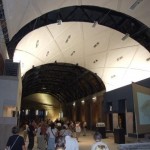It is exactly 460 years since the Riesensaal [Hall of the Giants] built on a monumental scale, came into being. The Riesensaal, which dominated the Residenzschloss in its role as the principal hall, takes its name from the gigantic warrior figures painted on the walls between its renaissance windows.
 Here, in an area extending over more than 700 m2, guests were received and exuberant festivities celebrated. It was a setting for festivities and events intended to enhance the status and prestige of the Saxon rulers and their court. Although the design of the Riesensaal altered several times during the 180 years of its existence, its dimensions remained unchanged – until 1733. This was the year that August the Strong died and his son, Elector Friedrich August II, who also reigned as King August III of Poland, brought about the demise of the great hall he had inherited from his predecessors. At his behest, a false ceiling was installed, the space was subdivided into several rooms over two floors, and a private chapel was constructed for the use of his Habsburg wife. An architectural era had come to an end.
Here, in an area extending over more than 700 m2, guests were received and exuberant festivities celebrated. It was a setting for festivities and events intended to enhance the status and prestige of the Saxon rulers and their court. Although the design of the Riesensaal altered several times during the 180 years of its existence, its dimensions remained unchanged – until 1733. This was the year that August the Strong died and his son, Elector Friedrich August II, who also reigned as King August III of Poland, brought about the demise of the great hall he had inherited from his predecessors. At his behest, a false ceiling was installed, the space was subdivided into several rooms over two floors, and a private chapel was constructed for the use of his Habsburg wife. An architectural era had come to an end.
For a period of 280 years, the Riesensaal, the great hall of the Dresden Residenzschloss, ceased to exist. In recent years, however, it has been magnificently recreated, and can now be presented to the public as a setting for the enjoyment of art and cultural history. The Rüstkammer [Armoury] of the Staatliche Kunstsammlungen Dresden, recognised as one of the world’s finest collections of ceremonial weapons, armour and costume, will now use the new Riesensaal as a magnificent stage for an unparalleled display. The tournament culture of the 16th century is brought vividly to life, with life-size figures of riders, dressed in magnificent armour, armed with lances and other ceremonial weaponry, and mounted on deceptively realistic horses which are actually made of wood.
On entering the monumental Riesensaal, visitors are immediately transported back into history, as they become eye-witnesses to a historic joust with sharp lances between Elector August of Saxony and Fabian von Schoenaich. This scene is typical of the dramatic exhibits presenting many of the more than 350 objects on display here – the Riesensaal opens up a whole new world of experiences. Three of the most important tournament events, originally used as training for battle, and later an important part of court ceremonial and festivities, are recreated. The objects used in these reconstructions are a selection of important armor and weapons dating from the 15th to the 17th century, chosen from the extensive holdings of the Rüstkammer (weapon arsenal).
For the Rüstkammer, this represents a second stage in its move into the Residenzschloss, where it has already had a significant presence since 2010, in the form of its magnificent Türckische Cammer. Although the Rüstkammer has existed as a museum in Dresden since 1586, with the move into the Riesensaal, it has completely reinvented itself.
Since 1990, the rebuilding of the Residenzschloss, extensively damaged in the Second World War, has been one of the major cultural projects undertaken by the Free State of Saxony. Thanks to the success of this reconstruction work, over the last ten years several museums and sections of the collections of the Staatliche Kunstsammlungen have been able to move into new accommodation which meets the exacting standards required by modern museums. These include the Kupferstich-Kabinett [Cabinet of Prints and Drawings], the Neues Grünes Gewölbe [New Green Vault] and the Historisches Grünes Gewölbe [Historic Green Vault] and most recently, the Türkische Kammer. The opening of the new Riesensaal is an important landmark on the way to completion of the Residenzschloss in its new incarnation as the both the original source and the current home of the Staatliche Kunstsammlungen Dresden.
Peter Kulka, the architect responsible for the reconstruction of the Residenzschloss, and the Staatsbetrieb Sächsisches Immobilien- und Baumanagement, the Free State of Saxony’s property and construction management company, have retained the original dimensions and the form of the imposing barrel-vaulted ceiling of the Early Baroque 17th-century hall in their contemporary reinterpretation – a design which gives generous space to the objects on display, and makes them the focus of attention.
Since 2006, the Staatliche Kunstsammlungen Dresden have benefited from their partnership with the Sparkassen-Finanzgruppe, the German Savings Banks Finance Group, which has over several years been a constant source of assistance and support in a range of museum projects and special exhibitions. The support of the Sparkassen-Finanzgruppe has also made a major contribution to the opening of the new Riesensaal.
_______________________________________________________________________________________